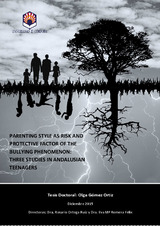Mostrar el registro sencillo del ítem
Parenting style risk and protective factor of the bullying phenomenon: Three studies in Andalusian teenagers
| dc.contributor.advisor | Ortega Ruiz, Rosario | |
| dc.contributor.advisor | Romera Félix, Eva M. | |
| dc.contributor.author | Gómez Ortiz, Olga | |
| dc.date.accessioned | 2015-12-09T10:04:48Z | |
| dc.date.available | 2015-12-09T10:04:48Z | |
| dc.date.issued | 2015 | |
| dc.identifier.uri | http://hdl.handle.net/10396/13151 | |
| dc.description.abstract | In the last forty years, research on bullying has progressed considerably, producing a large body of scientific knowledge. The development of research in this field has permitted defining the nature of this violent phenomenon, determining its prevalence in different parts of the world, the consequences which could be suffered by those directly involved, and the risk or protective factors which can protect children from engaging in bullying, or promote their active participation in it (Hymel & Swearer, 2015; Zych, Ortega-Ruiz, & Del Rey, 2015). Among these factors, the role of emotional intelligence, social competence, and of those related to the family environment, the peer group or the school setting has been highlighted (Álvarez-García, García, & Nuñez, at press; Cook, Williams, Guerra, Kim, & Sadek, 2010). However, the family – a fundamental developmental context in the lives of individuals – and specifically parenting styles, have not yet been studied in enough depth in relation to bullying. In this regard, previous research has examined the role of affection and parental control in bullying involvement (Baldry & Farrington, 2005; Espelage, Bosworth, & Simon, 2000; Kawabata, Alink, Tsen, Van Ijzendoorn, & Crick, 2011; Nickerson, Mele, & Princiotta, 2008), but it has not reflected the latest developments in the study of parenting styles which take into account other parental dimensions beyond affection and control, such as promotion of autonomy or humor (Oliva, Parra, Sanchez-Queija, & López, 2007). Moreover, some studies have linked the traditional typology of parenting styles proposed by Baumrind and extended upon by Maccoby and Martin (democratic, permissive, authoritarian, and neglectful) to bullying involvement (Baldry & Farrington, 2000; Chaux & Castellanos, 2015; Yubero, Larrañaga, & Martínez, 2013). The most recent studies of parenting styles, however, suggest the limited utility of this typology in analyzing child and adolescent psychosocial development in Western society, where most parents are usually democratic (Hoeve, Dubas, Gerris, Van del Laan, & Smeenk, 2011; Oliva, Jiménez, Parra, & Sánchez-Queija, 2008; Torío, Peña, & Rodríguez, Extended abstract 6... | es_ES |
| dc.format.mimetype | application/pdf | es_ES |
| dc.language.iso | spa | es_ES |
| dc.publisher | Universidad de Córdoba, Servicio de Publicaciones | es_ES |
| dc.rights | https://creativecommons.org/licenses/by-nc-nd/4.0/ | es_ES |
| dc.subject | Bullying | es_ES |
| dc.subject | Maltrato | es_ES |
| dc.subject | Intimidación | es_ES |
| dc.subject | Violencia | es_ES |
| dc.subject | Familia | es_ES |
| dc.subject | Desarrollo psicosocial | es_ES |
| dc.subject | Educación | es_ES |
| dc.title | Parenting style risk and protective factor of the bullying phenomenon: Three studies in Andalusian teenagers | es_ES |
| dc.type | info:eu-repo/semantics/doctoralThesis | es_ES |
| dc.rights.accessRights | info:eu-repo/semantics/openAccess | es_ES |

